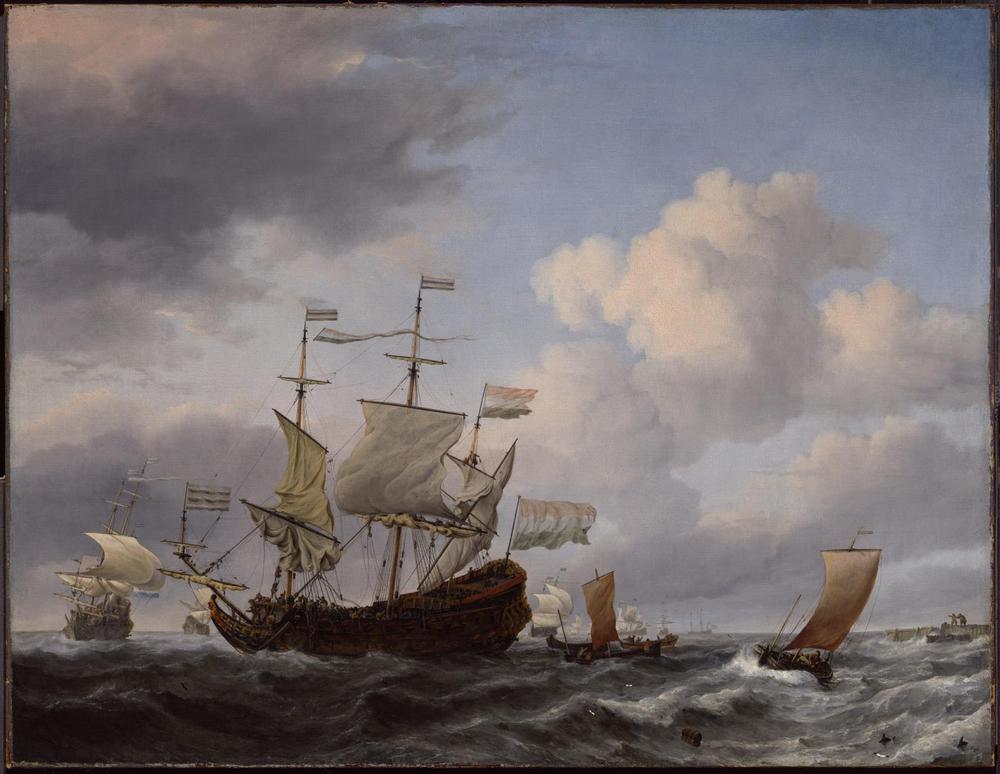Advanced Search 

A Dutch Flagship Coming to Anchor Close to the Land in a Fresh Breeze
Willem van de Velde the Younger (Dutch, 1633–1707)
about 1672
Medium/Technique
Oil on canvas
Dimensions
66 × 84.5 cm (26 × 33 1/4 in.)
Framed: 87 × 106.7 cm (34 1/4 × 42 in.)
Framed: 87 × 106.7 cm (34 1/4 × 42 in.)
Credit Line
Promised gift of Susan and Matthew Weatherbie, in support of the Center for Netherlandish Art
Accession NumberL-R 79.2023
OUT ON LOAN
CollectionsEurope
ClassificationsPaintings
Since Dutch art collectors were often well versed both in painting and the fine art of ship handling, painters took special care with maritime scenes; some, like van de Velde, specialized in them. Here, the artist carefully depicts both the structure of the ship and the movements of the crew as they prepare to anchor in a brisk breeze—a tricky maneuver. This may be the Utrecht, a warship that achieved fame in the wars between England and the Netherlands, particularly the Four Days’ Battle, where the Dutch fleet was victorious.
Signed
Signed with initial lower right: W/VV
ProvenanceBy 1765, Lawrence Dundas (b. 1712 - d. 1781), 1st Baronet, Aske Hall, North Yorkshire; by inheritance to his son, Thomas Dundas (b. 1741 - d. 1820), 1st Baron Dundas; May 31, 1794, posthumous Lawrence Dundas sale, Greenwoods, London, lot 33, sold for £262.10 to William Comyns (dealer), London, possibly for Anne Louisa Bertie (b. 1747 - d. 1841), Lady Stuart, London [see note 1]; May 15, 1841, Lady Stuart estate sale, Christie's, London, lot 77, sold to Brown for Robert Stayner Holford (b. 1808 - d. 1892), Westonbirt, Gloucestershire [see note 2]; to his son, George Lindsay Holford (b. 1860 - d. 1926), Westonbirt, Gloucestershire; May 17, 1928, Holford estate sale, Christie's, London, lot 68, sold for 4200 gns. to Joubert, probably for Robert Henry Benson (b. 1850 - d. 1929), Fairfield House, Fairfield [see note 3]; to his son, Constantine Evelyn Benson (b. 1895 - d. 1960), Shawford House, Hampshire; until at least 1990, his daughter, Gillian Benson Tomkins (b. 1923 - d. 2003), Winslow Hall, Buckinghamshire [see note 4]. Private collection, England. Private collection, Europe. March 2004, sold by Richard Green (dealer), London, to Susan and Matthew Weatherbie, Boston.
NOTES:
[1] According to M. S. Robinson, Van de Velde: A Catalogue of the Paintings of the Elder and the Younger Willem van de Velde (Greenwich: National Maritime Museum, 1990), vol. 2, p. 750, cat. no. 300.1, Comyns may have worked for Lady Stuart. It was certainly in her collection by 1835, with the publication of John Smith, A Catalogue Raisonné of the Works of the Most Eminent Dutch, Flemish, and French Painters, vol. 6 (London, 1835), p. 330, cat. no. 34.
[2] According to Smith (as above, note 1), vol. 9 (publ. London, 1842), p. 767, cat. no. 37, the painting was bought by Mr. Brown and was, at the time, in the collection of William Hornby. Robinson 1990 (as above, note 1), writes that Smith probably misidentified the painting in the Hornby collection, and that an annotation in a copy of the 1841 sale catalogue held by the Victoria and Albert Museum states that the painting was sold to “Brown for Mr. Holford.”
[3] Robert Henry Benson was George Lindsay Holford’s brother-in-law and the executor of his estate.
[4] See Robinson 1990 (as above, note 1), p. 750.
NOTES:
[1] According to M. S. Robinson, Van de Velde: A Catalogue of the Paintings of the Elder and the Younger Willem van de Velde (Greenwich: National Maritime Museum, 1990), vol. 2, p. 750, cat. no. 300.1, Comyns may have worked for Lady Stuart. It was certainly in her collection by 1835, with the publication of John Smith, A Catalogue Raisonné of the Works of the Most Eminent Dutch, Flemish, and French Painters, vol. 6 (London, 1835), p. 330, cat. no. 34.
[2] According to Smith (as above, note 1), vol. 9 (publ. London, 1842), p. 767, cat. no. 37, the painting was bought by Mr. Brown and was, at the time, in the collection of William Hornby. Robinson 1990 (as above, note 1), writes that Smith probably misidentified the painting in the Hornby collection, and that an annotation in a copy of the 1841 sale catalogue held by the Victoria and Albert Museum states that the painting was sold to “Brown for Mr. Holford.”
[3] Robert Henry Benson was George Lindsay Holford’s brother-in-law and the executor of his estate.
[4] See Robinson 1990 (as above, note 1), p. 750.
